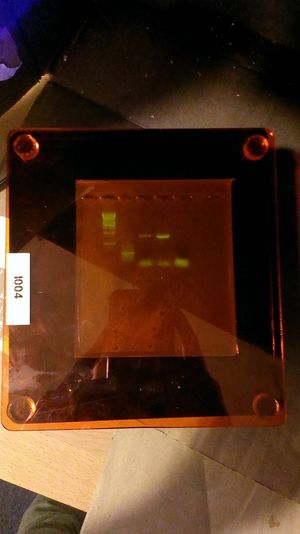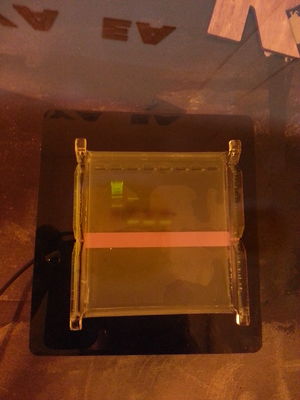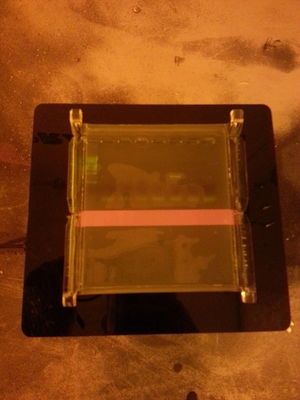Forskjell mellom versjoner av «BioHackerLab/Experimental»
m (lagt til i kategori Biohacking) |
|||
| (14 mellomliggende revisjoner av en annen bruker er ikke vist) | |||
| Linje 9: | Linje 9: | ||
=10 Jul 2016 - Bitraf PCR #2= | =10 Jul 2016 - Bitraf PCR #2= | ||
| − | [[Fil:Bitraf PCR ITS1 ITS4 july 10.jpg|miniatyr|Result of shortened PCR program july 10, using 30 cycles and no final extension step for amplification with primers ITS1 and ITS4 and same template as prepared July 5 (stored in freezer). From left to right: DSBio 1kb ladder (5 uL), PCR sample using 1 uL template (10 uL), PCR sample using 2 uL template (10 uL), negative control PCR sample (no template) (10 uL). For the second PCR sample, no PCR product band is visible and the reaction appears unsuccesful.]] | + | [[Fil:Bitraf PCR ITS1 ITS4 july 10.jpg|miniatyr|Result of shortened PCR program july 10, using 30 cycles and no final extension step for amplification with primers ITS1 and ITS4 and same template as prepared July 5 (stored in freezer). From left to right: DSBio 1kb ladder (5 uL), PCR sample using 1 uL template (10 uL), PCR sample using 2 uL template (10 uL), negative control PCR sample (no template) (10 uL). For the second PCR sample, no PCR product band is visible and the reaction appears unsuccesful.|sentrer]] |
| − | |||
=11 Jul 2016 - Bitraf PCR #3= | =11 Jul 2016 - Bitraf PCR #3= | ||
| Linje 16: | Linje 15: | ||
PCR was performed using the same PCR setup and program as July 10 except for the selection of templates and template amounts. The following templates and template amounts were used: | PCR was performed using the same PCR setup and program as July 10 except for the selection of templates and template amounts. The following templates and template amounts were used: | ||
| − | *HS1A: 1 uL yeast sample #1. | + | * #1/HS1A: 1 uL yeast sample #1. (S. Cerevisiae [1]) |
| − | *HS1B: 2 uL yeast sample #1. | + | * #2/HS1B: 2 uL yeast sample #1. (S. Cerevisiae [1]) |
| − | *HS2A: 1 uL yeast sample #2. | + | * #3/HS2A: 1 uL yeast sample #2. (Brettanomyces? [1]) |
| − | *HS2B: 2 uL yeast sample #2 | + | * #4/HS2B: 2 uL yeast sample #2. (Brettanomyces?[1]) |
| − | *P1: 1 uL S. cerevisiae (Idun tørrgjær. Template prepared 5 july stored in freezer) | + | * #5/P1: 1 uL S. cerevisiae (Idun tørrgjær. Template prepared 5 july stored in freezer) |
| − | *P2: 2 uL S. cerevisiae (Idun tørrgjær. Template prepared 5 july stored in freezer) | + | * #6/P2: 2 uL S. cerevisiae (Idun tørrgjær. Template prepared 5 july stored in freezer) |
| − | *NT: Reaction mix and primers only, no template. | + | * #7/NT: Reaction mix and primers only, no template. |
| + | |||
| + | The PCR samples were moved to freezer after completion of the PCR run. | ||
| + | |||
| + | [1]: Liquid cultures provided by Heikki. To prepare template, 50 uL liquid culture was incubated at 98C for 10 min in OpenPCR. | ||
| + | |||
| + | The samples were analzyed by electrophoresis July 24 2016. See the picture below: | ||
| + | |||
| + | [[Fil:July11PCRresult.jpg|miniatyr|sentrer|The result after electrophoresis of the PCR samples from the meetup 11 july 2016. Unfortunately, the results were rather disappointing. Out of the six PCR reactions, it appears that only one resulted in succesful amplification. Sample 5, using 1 uL of the solution previously prepared from dry baker's yeast as template, gave the expected band. There are several possible explanations for the failure of the other reactions to produce visible bands, including differences in template preparation, amount of template used and genetic differences between the yeast types. From left to right: DSbio 1kb ladder, PCR samples #1 , 2, 3, 4, 5, 6 and 7 (negative control). Electrophoresis was performed with 1% agarose at 100 V for 30 min.]] | ||
| + | |||
| + | ==Expected results/bioinformatics analysis== | ||
| + | |||
| + | '''Reference sequence:''' | ||
| + | |||
| + | One of the yeast samples was described as Brettanomyces. The most relevant organism in this genus appears to be Brettanomyces bruxellensis. The organism overview page at http://www.ncbi.nlm.nih.gov/genome/11901 lists Brettanomyces bruxellensis CBS 2499 (assembly Dekkera bruxellensis CBS 2499 v2.0, Assembly accession no. GCA_000340765.1) as the representative genome for this organism. | ||
| + | |||
| + | '''BLAST search:''' | ||
| + | |||
| + | A BLAST search was performed in the GCA_000340765.1 assembly with the expected PCR product sequence for amplification with primers ITS1 and ITS4 from S. cerevisiae, as determined by in silico PCR ([https://genome.ucsc.edu/cgi-bin/hgPcr?hgsid=500810913_rmZAxNnexxkDaK66dHwLt86MeALA&org=S.+cerevisiae&db=sacCer3&wp_target=genome&wp_f=TCCGTAGGTGAACCTGCGG&wp_r=TCCTCCGCTTATTGATATGC&Submit=submit&wp_size=4000&wp_perfect=15&wp_good=15&boolshad.wp_flipReverse=0 link]). The search returned 15 hits ("Sequences producing significant alignments". The longest 100% matching sequence stretch was 17 bp long, having an Expectation value ("E value"; roughly, the expected number of identical results encountered by chance) of 5.1. The hit with lowest Expectation value and the only hit with an E value below 1, is a 34bp stretch with 28/34(82%) matching nucleotides and an E value of 0.42. | ||
| + | |||
| + | Likewise a blastn search was performed with the ITS1 primer sequence as query. The search returned 194 hits and 94 sequences producing significant alignments. Several hits had 100% query coverage and 100% identity. However, the lowest E value reported was 25. Search with megablast/discontigous megablast did not return any hits. | ||
| + | |||
| + | Finally, a blastn search was likewise performed with the reverse complement of the ITS4 primer sequence. The search returned 200 hits and 100 sequences producing significant alignments, including several hits with 100% query coverage and 100% identity. The lowest E value was 0.49. | ||
| + | |||
| + | [[Category:Biohacking]] | ||
Nåværende revisjon fra 6. sep. 2017 kl. 11:28
Experiments performed at Bitraf.
Innhold
05 Jul 2016 - Bitraf PCR #1

10 Jul 2016 - Bitraf PCR #2

11 Jul 2016 - Bitraf PCR #3
PCR was performed using the same PCR setup and program as July 10 except for the selection of templates and template amounts. The following templates and template amounts were used:
- #1/HS1A: 1 uL yeast sample #1. (S. Cerevisiae [1])
- #2/HS1B: 2 uL yeast sample #1. (S. Cerevisiae [1])
- #3/HS2A: 1 uL yeast sample #2. (Brettanomyces? [1])
- #4/HS2B: 2 uL yeast sample #2. (Brettanomyces?[1])
- #5/P1: 1 uL S. cerevisiae (Idun tørrgjær. Template prepared 5 july stored in freezer)
- #6/P2: 2 uL S. cerevisiae (Idun tørrgjær. Template prepared 5 july stored in freezer)
- #7/NT: Reaction mix and primers only, no template.
The PCR samples were moved to freezer after completion of the PCR run.
[1]: Liquid cultures provided by Heikki. To prepare template, 50 uL liquid culture was incubated at 98C for 10 min in OpenPCR.
The samples were analzyed by electrophoresis July 24 2016. See the picture below:

Expected results/bioinformatics analysis
Reference sequence:
One of the yeast samples was described as Brettanomyces. The most relevant organism in this genus appears to be Brettanomyces bruxellensis. The organism overview page at http://www.ncbi.nlm.nih.gov/genome/11901 lists Brettanomyces bruxellensis CBS 2499 (assembly Dekkera bruxellensis CBS 2499 v2.0, Assembly accession no. GCA_000340765.1) as the representative genome for this organism.
BLAST search:
A BLAST search was performed in the GCA_000340765.1 assembly with the expected PCR product sequence for amplification with primers ITS1 and ITS4 from S. cerevisiae, as determined by in silico PCR (link). The search returned 15 hits ("Sequences producing significant alignments". The longest 100% matching sequence stretch was 17 bp long, having an Expectation value ("E value"; roughly, the expected number of identical results encountered by chance) of 5.1. The hit with lowest Expectation value and the only hit with an E value below 1, is a 34bp stretch with 28/34(82%) matching nucleotides and an E value of 0.42.
Likewise a blastn search was performed with the ITS1 primer sequence as query. The search returned 194 hits and 94 sequences producing significant alignments. Several hits had 100% query coverage and 100% identity. However, the lowest E value reported was 25. Search with megablast/discontigous megablast did not return any hits.
Finally, a blastn search was likewise performed with the reverse complement of the ITS4 primer sequence. The search returned 200 hits and 100 sequences producing significant alignments, including several hits with 100% query coverage and 100% identity. The lowest E value was 0.49.